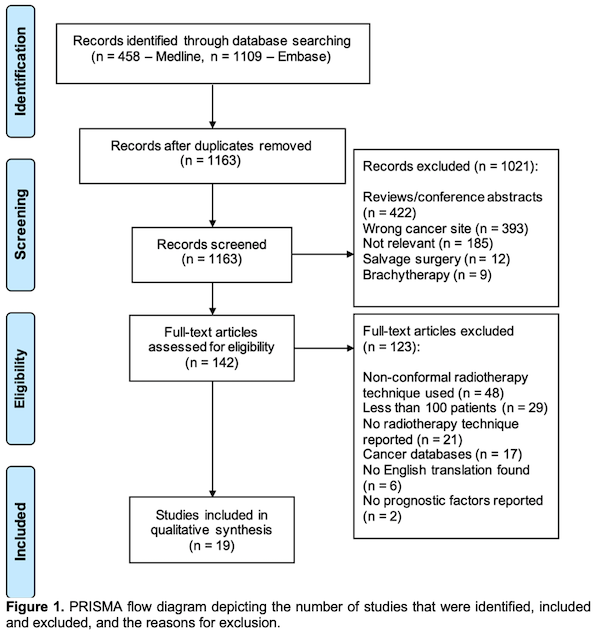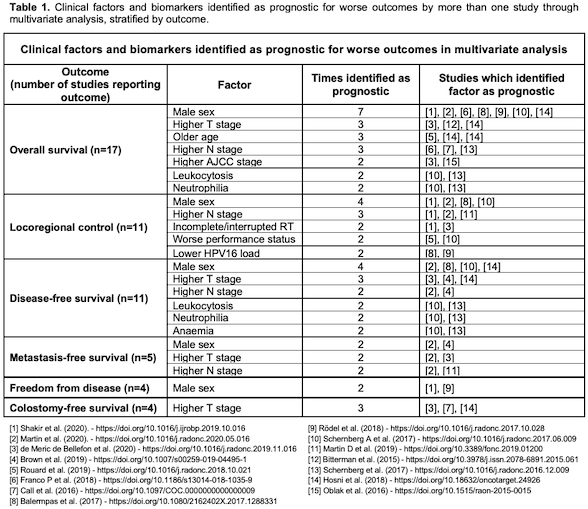Prognostic factors for anal cancer treated with conformal radiotherapy – a systematic review
Stelios Theophanous,
United Kingdom
PO-1321
Abstract
Prognostic factors for anal cancer treated with conformal radiotherapy – a systematic review
Authors: Stelios Theophanous1, Robert Samuel1, John Lilley2, Ann Henry1, David Sebag-Montefiore1, Alexandra Gilbert1, Ane Appelt1
1The University of Leeds, Leeds Institute of Medical Research at St James's, Leeds, United Kingdom; 2Leeds Cancer Centre, St James's University Hospitals, Department of Medical Physics, Leeds, United Kingdom
Show Affiliations
Hide Affiliations
Purpose or Objective
Anal cancer is a rare cancer, primarily treated using concurrent chemoradiotherapy (CRT), with IMRT and VMAT being the current standard conformal techniques. However, due to the rarity of anal cancer, there is still very limited consensus on prognostic factors for outcome following conformal CRT. This systematic review aims to evaluate the existing literature to identify prognostic factors for oncological outcomes in anal cancer, focusing on patients treated with curative intent using contemporary conformal radiotherapy techniques.
Material and Methods
A literature search was conducted using Medline and Embase to identify studies reporting on prognostic factors for survival and cancer-related outcomes after conformal CRT for anal cancer. Studies were considered if they included ≥70% patients treated with conformal radiotherapy techniques (3D-defined targets on computed tomography (CT), beams conformed to targets), reported survival or disease-related outcomes, and examined prognostic factors for outcomes using univariate (UVA) or multivariate (MVA) analysis. Studies were excluded if patients were treated with 2D radiotherapy techniques and/or fields based solely on bony landmarks, if cohorts included less than 100 patients or were derived from population-level databases, or if treated with palliative intent. All meta-analysis studies, reviews, animal model studies, conference abstracts/letters and studies without English translation were excluded. Studies published after 1st January 2000 and up to 1st July 2020 were considered. Prognostic factors which were identified as significant in UVA and MVA by each study were extracted. The factors were grouped into three broader categories: clinical factors, biomarkers and imaging factors. Only factors reported as prognostic in more than one study were included in the final results.
Results
The results from 19 studies were analysed (Figure 1). In both UVA and MVA analysis, higher T stage, higher N stage, and male sex were the most prevalent and reliable clinical prognostic factors for inferior outcomes. This was the case for the majority of outcomes explored (Table 1). Only a few biomarkers have been identified as prognostic by more than one study – pre-treatment biopsy HPV load, as well as the presence of leukocytosis, neutrophilia and anaemia at baseline measurement. The results also highlight the lack of studies with large cohorts exploring the prognostic significance of imaging factors. No imaging factors were identified as prognostic by more than one study.


Conclusion
Establishing a set of prognostic and potentially predictive factors for anal cancer outcomes can guide the risk stratification of patients, aiding the design of future clinical trials. Such trials will in turn provide us with greater insight into how to effectively treat this disease using a more personalised approach.